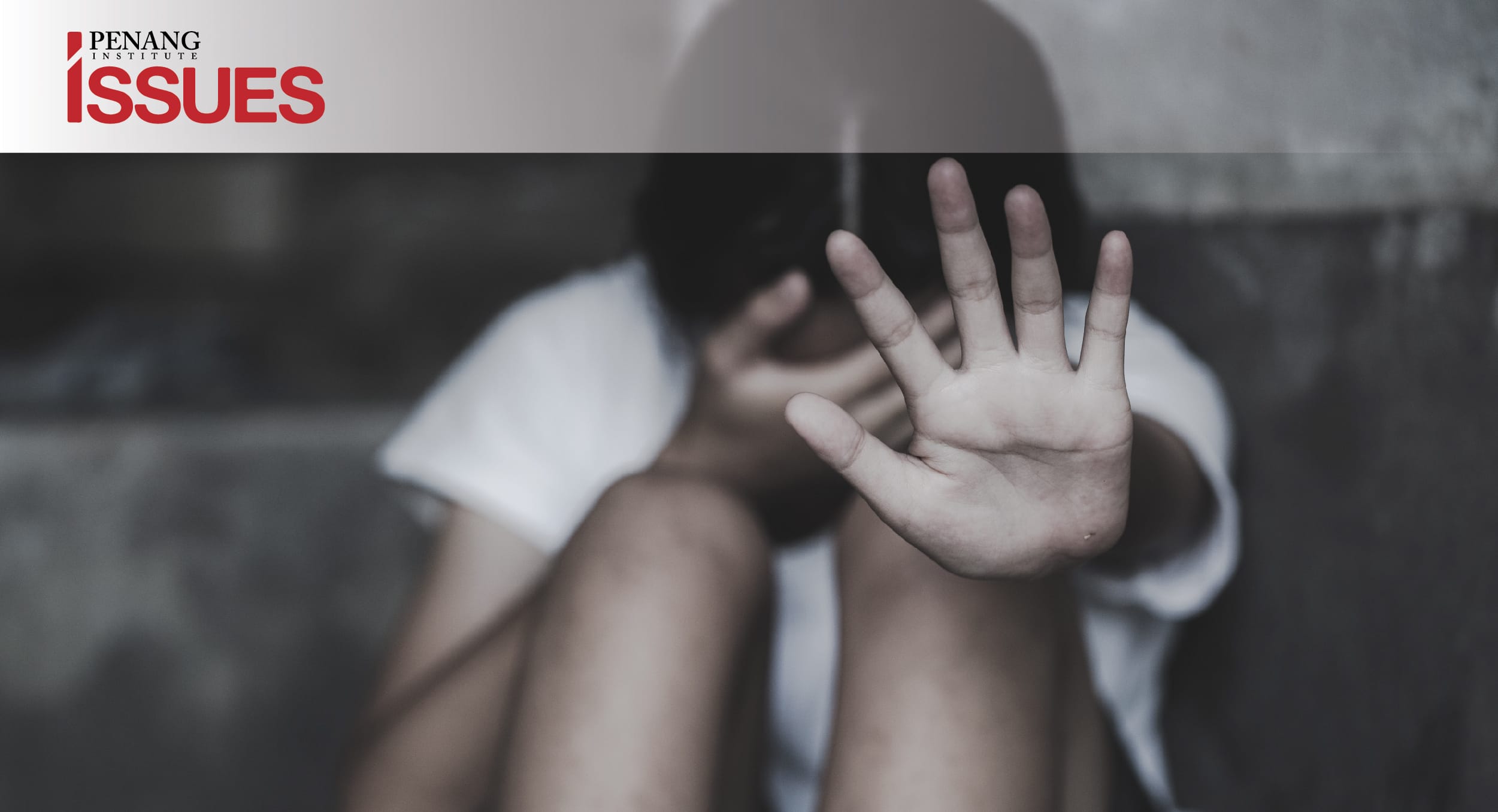Executive Summary
- Statistics from the Department of Social Welfare and the Royal Malaysia Police show that cases of child sexual abuse (CSA) have been rising in the past few years; furthermore, since many cases go unreported, the actual extent of the problem is in reality much greater than officially recognised
- Where online sexual exploitation and abuse of children (OSCEA) is concerned, there is scarce data on the number of victims, and preventive mechanisms are far from adequate
- Preventive measures such as child-friendly case reporting mechanisms, targeted awareness campaigns, and equipping children with digital literacy, need to be strengthened. There is also a need for more child protection workers
- The paper also argues for better protection for children with irregular immigration status who have been trafficked for sexual purposes
Introduction
Since acceding to the Convention on the Rights of the Child (CRC) in 1995, the Malaysian government has shown commitment in addressing the issue of child abuse in general and child sexual abuse in particular. The Out of the Shadows Index by the Economic Intelligence Unit (EIU) which measures how countries address child sexual abuse (CSA) by assessing legislation, policies, and responses ranked Malaysia 23rd out of 60 countries, with a score of 54.52 in 2019[1].
This paper highlights the issues of CSA and OCSEA in Malaysia, and argues for the need to strengthen preventive measures. The study provides a general overview of the situation and has primarily relied on a desk review of reports and academic articles published in the last five years, and on the documents available online and documents written in English.
Statistics from the Social Welfare Department show that the number of children who are victims of sexual abuse and who need protection have been steadily increasing every year. The reported figure was 46 in 2015 and 60 in 2016, and increased markedly to 148 children in 2017, 113 in 2018, and 146 in 2019.[2] In the first six months of 2020 alone, the Royal Malaysia Police recorded a total of 1,721 cases of sexual crime against children.[3] Separately, the Ministry of Women and Community Development recorded 2,040 child abuse cases in the first four months of 2021, 30% of which were victims of physical and sexual abuse.[4]
While these statistics are useful, these numbers do not reflect the actual extent and gravity of CSA in Malaysia. This is because many cases go unreported.[5] A report by The Star in 2019 states that community studies suggest that one in ten children are sexually abused, usually by the father or stepfather of the victim.[6]
Apart from that, cases that involve irregular status children such as stateless and refugee children are also not captured in the national statistics. These children are often not covered by the protection mechanisms of the state. For example, UNHCR has received reports of cases where refugee children in Malaysia who have been abused or neglected have been denied medical treatment and other support.[7] Furthermore, instead of protection, irregular status children face the threat of deportation and detention; this deters them from seeking formal assistance. Abused children with irregular status are at high risk of being trapped in a cycle of violence.
Separately, ECPAT International reported that Malaysia has been identified as a sex trafficking destination with victims from all over the region: Thailand, Indonesia, Myanmar, India, Bangladesh, The Philippines, Vietnam and China.[8] The majority of these victims are women and girls; however, from 2016 to 2018, 15 boy victims were also identified.[9] According to child rights activists in Malaysia, thousands of trafficked children from the region are forced into the sex industry which operates in dilapidated low-cost apartments in Kuala Lumpur rather than brothels.[10] Malaysia has also been reported as a transit country for victims of trafficking.
Growing Threat of Online Child Sexual Exploitation and Abuse (OCSEA)
Online Child Sexual Exploitation and Abuse (OCSEA) is another area of concern. As children and adolescents become more reliant on the internet, the threat of OCSEA grows in tandem. A global study by the International Telecommunication Union in 2013 learned that Malaysia had the world’s fourth highest proportion of digital natives, with almost 75% of its youth in this category.[11] The 2014 National Survey Report conducted on cyber safety among schoolchildren revealed that 40% of children did not know how to protect themselves, 83% were vulnerable to online risks due to minimal protective actions taken, and more than 70% admitted to have carried out various forms of online harassment, such as name calling, posting improper messages, and sending inappropriate photos. More than 40% acknowledged that online safety was important but nevertheless took low levels of protection.[12]
Separately, results from the Internet Users Survey 2020 conducted by the Malaysian Communications and Multimedia Commission (MCMC) show that the number of children age five to 17 years old who use the internet has grown by 155% since 2016.[13] In 2016, only 18.4% of children age five to 17 were using internet, but by 2020, this figure had grown to 47%.
Based on these data, one can conclude that children are increasingly reliant on the internet and are exposed to various social media applications to a greater extent. However, reliance on internet cuts both ways. While it provides a space for children for entertainment and learning, it also exposes children to a different set of dangers such as cyberbullying, game addiction and OCSEA.
OCSEA involves the use of communication technology to sexually abuse or exploit children. The types of OCSEA include online grooming, sextortion, as well as livestreaming, production, and distribution of sexual content involving children. Online grooming typically involves the practice of a predator befriending a child online with the intention of sexually abusing the child after gaining his or her trust. Ill-equipped teenagers, in particular, are vulnerable to fall prey to such crimes as they will be manipulated into thinking that they are in a romantic relationship with their abusers. As they begin to trust these predators, they could be at risk of being tricked into sending suggestive pictures of themselves to the predators. In the worst case scenario, actual sexual assault could happen when the online grooming escalates to physical meeting. According to Kaiser Ho, the Public Relations Officer of Monsters Among Us, a local NGO that works on combating child sexual violence, it is possible that cases of online grooming may have risen during the Covid-19 pandemic because teenagers have been confined at home, and social media platforms are the outlets that they can utilise to seek social interaction.
Sextortion refers to situations where a predator blackmails a child after gaining access to his or her sensitive or private pictures or videos. Livestreaming of sexual content of children involves real-time streaming of child abuse in the dark web, social media platforms, or any other communication apps. Offenders commit abuse on the child by paying to watch these videos, communicating with the child, or requesting the child to perform sexual acts for them.
Official data on how many children have fallen prey to OCSEA are scarce. But a study by UNICEF (2019) reported that two thirds of the participants from their study, which includes children from Malaysia, Indonesia, Cambodia, and Thailand, have encountered adverse or upsetting experiences online, ranging from cyberbullying to attempts at sexual exploitation.[14] It has also been found that 80% of the rape victims in Malaysia who met their predators through the internet are children between the ages of 10 and 18.[15] Both boys and girls are found to have reported receiving sexual messages and images on social media.[16] Meanwhile, another UNICEF (2016) study found that three out of four teenagers agree that children are in danger of being sexually abused or taken advantage of online.[17] A documentary series by The Star’s R.AGE team in 2016 have also exposed how predators groomed teenagers via social media apps. Disturbingly, the predators had proudly and unashamedly flaunted their number of victims to the undercover journalist.[18]
In a more recent time in August 2020, a 17-year-old teenage girl committed suicide after her boyfriend threatened to leak her nude pictures on social media platforms. When the authorities apprehended the offender and confiscated his mobile phone, they found more naked pictures of other women. The offender would use these pictures to blackmail these women into having sex with him.[19]
Along with its reputation of being a sex trafficking destination, Malaysia is also recognised as a haven for the commission of online child pornography and is the third highest nation in Southeast Asia for the ownership and distribution of child pornography.[20] Australian detectives investigating paedophiles in the region believe that Malaysia has become one of Southeast Asia’s biggest centres for the transmission of child pornography on the internet.[21] In September 2021, the Australian Federal Police detained one of the top ten wanted online child sex offenders in the world in Kuching, Sarawak.[22]
Laws that Protect Children
Since acceding to the Convention on the Rights of the Child (CRC) in 1995, the Malaysian government has shown commitment in addressing the issue of child abuse in general and child sexual abuse in particular.
The laws that govern the protection of children in Malaysia include the Sexual Offences Against Children Act 2017 (SOACA), the Domestic Violence Act 1994, the Education Act 1996, the Evidence of Child Witness Act 2007, the Penal Code, the Criminal Procedure Code, the Legal Aid Act 1972, the Guardianship of Infants Act 1961, and the Law Reform (Marriage and Divorce) Act 1976[23]. Malaysia has also established a National Child Representative Council which aims to give voice to the rights of children in Malaysia in terms of their life, development, participation, and overall protection.
To combat the rising threat of online crimes against children, the Royal Malaysia Police also launched the Malaysia Internet Crime Against Children Investigation Unit (MICAC) in 2018. MICAC is a special task force to combat the spread of sexually explicit photos, videos, or audio recordings of children. Along with MICAC, the Internet Crimes Against Children: Child Online Protective Services (ICACCOPS), a monitoring software to assist child crime investigations was also launched by the Royal Malaysia Police.[24]
In terms of protection services, the Department of Social Welfare in Malaysia provides shelters for children who are victims of abuse. These children are usually referred by the police, private and public medical centres or hospitals, schools, citizens, childcare centres, NGOs, the media, the court or through Talian Kasih – a hotline run by the Ministry of Women, Family, and Community Development. Children may also make reports to Childline Malaysia at 15999. Meanwhile, cases of online child sexual exploitation or abuse (OCSEA) can be reported to Cyber999 through phone calls, SMS, email, or the Cyber999 mobile app. The One Stop Crisis Centres at hospital emergency rooms are also equipped to assist victims of sexual assault or abuse.
There are also various NGOs in Malaysia that provide support, counselling, legal advice, and shelter for children in need. These NGOs also run advocacy campaigns for children as well as adults.
Challenges in Addressing CSA and OCSEA
In spite of existing legislations and efforts to combat CSA and OCSEA, challenges to address this heinous crimes persist. For instance, although the SOACA 2017 encompasses online grooming or sexual exploitation, there are limitations in the legislations. For example, in 2018, 17,338 IP addresses that uploaded and downloaded CSA content to and from the internet and 400 websites that contain CSA material were identified. While these materials were blocked following public complaints, no prosecutions or convictions were meted out.[25] Merely blocking these materials without tracking down the offenders is demonstrably ineffective as the offenders would move to the dark net or other encrypted networks to continue their abuse.
And despite the establishment of MICAC and ICACCOPS to combat online transmission of child pornography content, Malaysia scores 0/100 in the Out of the Shadows indicator for internet protection.[26] (A score of 0 indicates a poor environment while a score of 100 indicates the opposite). The police are generally reluctant to investigate child pornography cases without a police report being lodged by a purported victim. There is also a lack of understanding within the police force on the wide ambit of the provisions under the SOACA in relation to child pornography and the implications child pornography has on children.[27]
Additionally, child participation in the political and social mechanisms developed to protect children specifically from child sexual exploitation is rare.[28] Compensation of child victims of sexual exploitation is also not a well-established process in Malaysia.[29] Without any strong political mechanism dedicated to child rights and issues, it will be difficult to push for better policies to protect children from CSA and OSCEA.
Aside from legal enforcement and legislations, challenges in addressing CSA occur when guardians of the victims are reluctant to report the cases. For some, the desire to cover the family shame may outweigh the need to protect the child victim. The desire to cover up the crime is even more pronounced if the crime is committed by a guardian or a family member. For example, if the offender is the head or breadwinner of the family, other adults in the household may feel afraid to speak out or disrupt what they have known as normalcy. Relatives or friends who have suspicions that child abuse is happening in a particular household may also be reluctant to interfere especially when they cannot ascertain if CSA is indeed happening. Alternatively, some may be afraid that their interference may escalate the tension, while others just simply do not want to be involved.
In cases where the child is sexually abused by an outsider, some families may not want to report to the authorities because they do not want to go through the long arduous process of investigation with the child victim. It is also possible that some may not trust the authorities.
In addition, in scenarios where there is power imbalance between the victim and perpetrator, it could compound the challenges in protecting children from CSA and OCSEA. For example, if the offender is much wealthier or powerful than the victim’s family, he or she could pay off the family as a form of settlement to avoid prosecution. In cases where the child victim is pregnant, the family of the victim may even arrange the victim to marry the perpetrator. The rationale is that the victim could have a family and the child conceived out of rape will not be an illegitimate child. But such forms of solution do not prevail the need and justice for the victim. Instead it creates an environment in which CSA can occur with impunity.
Feelings of guilt, shame, embarrassment and fear of not being believed can stop a child from disclosing the abused that they have suffered.[30] This is especially when the offender is a close family member, such as father, uncle or stepfather. In such scenario, the child may think that no one in the family would trust his or her confession or they may also not want to say it out to avoid causing any disruption to the family. Not knowing what could happened after the disclosure is a strong impediment.
Studies have revealed cases where children who have disclosed abuse said that they had not been believed, had their feelings minimised, been accused lying and been threaten by other family members.[31] Child victims would in many cases presumably have been threatened by the offender to not tell anyone.
Another related challenge that hinders progress in combating CSA is that sexual crimes against children are a rarely discussed issue in schools or at home. Although sexual education is incorporated in school curriculum, teachers may not necessary feel properly equipped to teach the subject in a holistic manner. Beyond legislations, preventive measures that include the participation of children is much needed. The following section proposes a few recommendations.
Addressing CSA and OCSEA: Policy Recommendations
1. Strengthen Existing Child-Friendly Mechanisms
Government mechanisms such as Talian Kasih, Childline Malaysia, and Cyber999 are commendable and must be publicised in schools. However, it is important to realise that children or their family members may be deterred from making official reports due to a variety of reasons, such as fear or distrust of authorities.
This is where NGOs can collaborate with the government to introduce more child-friendly mechanisms. One such example in Malaysia is LaporPredator[32]. Initiated by the youth-based NGO called Monsters Among Us, LaporPredator is an online chatbot that victims can access via the LaporPredator website or through their WhatsApp application and where they can choose to report their cases anonymously. These reports are then filtered by trained child protection volunteers who will offer additional support to the victims. When needed, the child protection volunteer or manager will help the reporting person channel their case to the relevant authorities for further action.
Partnering with NGOs does not mean that government mechanisms are ineffectual. Instead, it is to recognise that children may feel more comfortable expressing themselves on less intimidating platforms. Thus, such mechanisms should be introduced in schools.
2. Incorporate Digital Literacy and Holistic Sexual Education in School and at Home
Most children know how to use the internet but not all are equally capable in protecting themselves from the risks they might encounter on the internet. Therefore, holistic digital literacy that is age-appropriate should be introduced in schools. Besides equipping children with technical skills, they also need to be taught to be cautious when they are approached by strangers in cyberspace. For instance, the Education Ministry could introduce educational webtoons or printed materials with pictures for students to better comprehend the issue of CSA and OSCEA, as well as lessons on how to protect themselves. Concrete examples of words or cues that predators would use to groom children also have to be discussed openly in schools and at homes so that children are equipped to identify potential danger and know how to protect themselves. At the same time, children need to be taught to exercise discretion when sharing their personal information or pictures to friends. Besides teachers, parents should also play an active role in equipping their children with digital literacy and monitor their children’s online activities.
Although sex education has been incorporated in schools, there are still existing barriers in providing children with holistic sex education. This is one area schools can improve on. Through holistic sex education, children could be better equipped to protect themselves and better understand the risks involved in sexual activity.
3. Institute and Increase Targeted Awareness Campaigns
Instituting awareness campaigns is one area that authorities, social workers, community-based organisations and schools can partner with parent teacher associations. For instance, the nationwide year-long campaign #SayaSayangSaya provided 1,564 young people from 316 schools in Malaysia with opportunities to learn and openly discuss reproductive health issues, child sexual abuse and cyber safety, with experts from the police’s Sexual, Women, and Child Investigation Unit[33].
At the state level in Penang, the Women’s Centre for Change spearheaded various targeted outreach programmes for schools, such as Bijak Itu Selamat (BIS) for Educators, the Ok Tak Ok Programme for Children, the Cybersafety Programme for Teenagers, RESPEK for Teenagers, Finding My Voice for Girls, and Boyz Programme for Boys.[34]
Targeted awareness campaigns such as these which cater to specific audiences create a safe space for the participants to share their concerns and can with great benefits be replicated in other states. Besides creating more awareness, such programmes also make organisers and volunteers more cognisant of the changing nature of CSA and OCSEA.
4. Include Adolescents in Discussions that Focuses on Child Rights
Perhaps, the most challenging part in combating CSA and OSCEA is the lack of priority given to child rights. To change this, local governments, the national government and other stakeholders have to be committed in the discussion on prevailing social norms and practice. For instance, local governments could dedicate a special committee to look at issues concerning children; the state government could facilitate discussions with local leaders, medical officers, legal experts and NGOs to whether prevailing practices truly serve the needs of the children and discuss what the areas are that could be changed to better protect children from CSA and OSCEA.
In these discussions, it is also important to involve adolescents. Their views and concerns have to be taken in consideration so that better policies can be formulated to protect them.
5. Enlarge the Child Protection Workforce
Data from the Social Welfare Department show that the number of children who are in need of state care and protection has increased from year to year,[35] and the country struggles to create a sufficient effective child protection workforce. A 2018 UNICEF Malaysia survey reported that social service workers are gazetted across several areas, namely child protection, probation, and anti-trafficking operations. Furthermore, only 236 officers are involved in handling child protection cases and 183 officers manage cases with children who have come in conflict with the law.[36] Another study shows the ratio of social workers and victims of child abuse to be 1:20.[37]
The lack of trained social service workers certainly impedes the efficacy of the child protection system. The lack of dedicated child service workers was amplified during the Covid-19 crisis as government social service workers were reassigned to food relief services.[38] It is also critical that social workers who work with children are professionally trained and receive periodical training to stay updated.
6. Appropriate Training and Empowerment for Law Enforcement Agencies
Malaysia’s score of 0/100 for Internet Protection in the Out of the Shadows Indicator shows beyond doubt that a lot needs to be done. One area is for the police to review its existing procedures with regards to investigations into CSA and OSCEA cases. For instance, rather than taking a reactive approach where action can only be taken after a report is lodged, more proactive measures could be put in place to empower police officers to investigate and track down offenders.
The technological capacity of law enforcement agencies also needs to be improved. Law enforcement officers who handle cases related to OSCEA should be trained with digital forensics to keep up with the fast-changing internet ecosystem. They should be equipped with the technical skills to track down offenders that hide behind encrypted networks, and work closely with regional and international partners to track down predators. Police officers who handle cases of CSA and OSCEA should also be given more training on how to engage with victims with more sensitivity.
7. Protect Irregular Status Children
There is an urgent need to protect children of irregular immigration status, especially if these children are trafficked victims. As proposed by the Child Rights Coalition, Malaysia should adopt the CEDAW Committee’s recommendations on trafficking from its 2018 Concluding Observations to Malaysia, and establish a formal identification procedure that is applied uniformly throughout the country.
Victims should also be given appropriate services and protection such as temporary residence permits and redress, and not be punished for violations of immigration laws.[39]
*Image is just for illustration purpose.
For list of references and appendix, kindly download the document to view.
Editor: Ooi Kee Beng
Editorial Team: Sheryl Teoh, Alexander Fernandez and Nur Fitriah (Designer)
[1] https://outoftheshadows.eiu.com/wp-content/uploads/2019/01/MY_MALAYSIA_PROFILE.pdf
[2] Jabatan Kebajikan Malaysia
[3] Minderjeet Kaur. 2020. Over 1700 child sexual crime cases reported in first half of 2020, Free Malaysia Today, https://www.freemalaysiatoday.com/category/nation/2020/08/18/over-1700-child-sexual-crime-cases-reported-in-first-half- of-2020/
[4] Hakim Hassan. 2021, 2040 Child Abuse cases reported in the first four months of 2021. The Rakyat Post, https://www.therakyatpost.com/news/malaysia/2021/07/08/2040-child-abuse-cases-reported-in-first-four-months-of-2021- says-rina-harun/
[5] Jamhirah Abdullah et.al.2017. Underreporting of Child Abuse in Malaysia: Society’s Role in Prevention of Child Abuse, World Applied Sciences Journal, Vol. 35 (11), pp. 2507-2512.
[6] S.Indramalar. 2019. One in 10 Malaysian children are sexually abused, usually by those they trust, The Star Online, https://www.thestar.com.my/lifestyle/family/2019/11/29/betrayed-by-the-people-they-trust-the-most
[7] Child Rights Coalition Malaysia. 2019. Status Report on Child Rights 2019. https://wao.org.my/wp-content/
uploads/2020/11/CRCM-STATUS-REPORT-2019-FINAL.pdf
[8] ECPAT International.2016. Global Study on Sexual Exploitation of Children in Travel and Tourism. Regional Report: Southeast Asia. Thailand: Bangkok, https://www.ecpat.org/wp-content/uploads/2016/10/SECTT_Region-SOUTHEAST
-ASIA.pdf
[9] Ecpat Briefing Paper.2019. Sexual Exploitation of Children in Malaysia. Thailand: Bangkok, https://www.ecpat.org/ wp-content/uploads/2019/09/ECPAT-Country-Overview-Research-Report-Malaysia-2019.pdf
[10] Ibid.,29
[11] UNICEF and Telenor Group.2015. How to talk to your Children about the Internet. https://www.unicef.org/malaysia/ media/586/file/Talk%20to%20your%20children%20about%20the%20internet.pdf
[12] Ibid.,10
[13] MCMC, Internet Users Survey 2020, Cyberjaya :MCMC https://www.mcmc.gov.my/skmmgovmy/media/General/pdf/
IUS-2020-Report.pdf
[14] UNICEF.2019. How can understanding children’s online behavior inform protection strategies in East Asia? https://www.unicef-irc.org/publications/pdf/16.EAP.pdf
[15] Ecpat Briefing Paper.2019. Sexual Exploitation of Children in Malaysia. Thailand:Bangkok
[16] Bulger M and Burton P. 2020. Our Lives Online. UNICEF East Asia and the Pacific Regional Office and UNICEF Malaysia https://www.unicef.org/malaysia/media/1501/file/Our_lives_online_-_Executive_Summary.pdf
[17] UNICEF Malaysia.2016. The Internet: Cool or Ugly?. Malaysia: Kuala Lumpur
[18] R.AGE. 2016. My undercover date with a sex predator, Vol.2. https://www.rage.com.my/undercoverdate-vol2/
[19] Ameera Rosli. 2020. Underaged M’sian Girl Dies from Jumping Off 22nd Floor After Boyfriend Threatens to Leak Her Nudes. Juice Online. https://juiceonline.com/underaged-msian-girl-dies-from-jumping-off-22nd-floor-after-boyfriend- threatens-to-leak-her-nudes/
[20] Kirama Nasim Manbi Ushama and Juriah Binti Abd Jalil.2020. Malaysia’s Legal Response to Tackling the Crime of Online Child Pornography. IIUM Law Journal, Vol 28 (1): pp. 165-195
[21] A. Ananthalakshmi. 2016. How Malaysia allows child abuse to go unpunished. Reuters. https://www.reuters. com/article/us-malaysia-sexcrimes-insight-idUSKBN1390AT
[22] Malaysiakini. 2021. Australian police reveal dark web probe led to arrest of paedophile in Sarawak, https://www. malaysiakini.com/news/590037
[23] Child Rights Coalition Malaysia. 2019. Status Report on Child Rights 2019. https://wao.org.my/wp-content
/uploads/2020/11/CRCM-STATUS-REPORT-2019-FINAL.pdf
[24] Nabilah Hani Ahmad Zubaidi. 2021. Monitoring Internet Child Pornography (ICP) in Malaysia. Pertanika Journal of Social
Sciences and Humanities.Vol 29 (52): pp. 185-203
[25] Ecpat Briefing Paper. 2019. Sexual Exploitation of Children in Malaysia. Thailand: Bangkok
[26] Ibid
[27] Child Rights Coalition Malaysia. 2019. Status Report on Child Rights 2019. https://wao.org.my/wp-content/uploads
/2020/11/CRCM-STATUS-REPORT-2019-FINAL.pdf, p.43
[28] ECPAT Country Overview. A Report on the scale, scope and context of the sexual exploitation of children in Malaysia.
https://www.ecpat.org/wp-content/uploads/2019/09/ECPAT-Country-Overview-Research-Report-Malaysia-2019.pdf
[29] ECPAT Country Overview. 2019. A Report on the scale, scope and context of the sexual exploitation of children in Malaysia
[30] Ibid
[31] Alaggia, R. 2010. An ecological analysis of child sexual abuse disclosure: Considerations for child and adolescent mental
health. Journal of the Canadian Academy of Child and Adolescent Psychiatry=Journal De L’Académie Canadienne De Psychiatrie De L’enfant Et De L’adolescent, 19(1), 32–39, and Linell, H. 2015. The process of disclosing child abuse: A study of Swedish social services protection in child abuse cases. Child & Family Social Work, 22(4), 11–19. doi: 10.1111/cfs.12245
[32] https://www.laporpredator.org/
[33] ECPAT Country Overview. 2019. A report on the scale, scope and context of the sexual exploitation of children in Malaysia
[34] https://www.wccpenang.org/outreach/
[35] Jabatan Kebajikan Malaysia.
[36] UNICEF.2020. Avoiding a Child Welfare Crisis: Mitigating the Impact of Covid-19 Through Social Service Workforce Strengthening. https://www.unicef.org/malaysia/media/1751/file/Social%20Workers%20COVID19%20Policy%20Brief.pdf
[37] Habibie Bte Hj Ibrahim and Norhamidah Jarimal. 2018. Child Welfare and Social Work: The Legal, Political and Social Contexts of Malaysia, Malaysian Journal of Social Sciences and Humanities (MJSSH). Vol (3):3, pp1-5.
[38] UNICEF. 2020. Avoiding a Child Welfare Crisis: Mitigating the Impact of Covid-19 Through Social Service Workforce Strengthening
[39] Child Rights Coalition Malaysia. 2019. Status Report on Child Rights 2019. https://wao.org.my/wp-content/uploads
/2020/11/CRCM-STATUS-REPORT-2019-FINAL.pdf
You might also like:
![Recognising Malaysian Soft Power after May 9, 2018]()
Recognising Malaysian Soft Power after May 9, 2018
![Stuck in Traffic: Why Malaysia Does Not Have a Motorcycle Ride-hailing Sector]()
Stuck in Traffic: Why Malaysia Does Not Have a Motorcycle Ride-hailing Sector
![Logging in Ulu Muda Forest Reserve: Is Penang’s Water Security under Threat?]()
Logging in Ulu Muda Forest Reserve: Is Penang’s Water Security under Threat?
![Covid-19 Fuels Democratic Decline in Southeast Asia]()
Covid-19 Fuels Democratic Decline in Southeast Asia
![Raising the Alarm: Urgent Reforms Needed to Address PISA and Propel STEM Education]()
Raising the Alarm: Urgent Reforms Needed to Address PISA and Propel STEM Education







